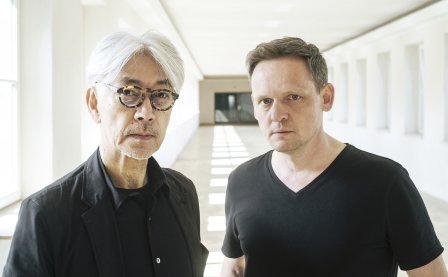Mutek’s 2017 Mexico City edition had some hiccups getting off the ground. The experimental electronic music and digital arts festival had been postponed for a month due to a pair of earthquakes striking within weeks of each other. The second, registering a 7.1 on the Richter scale, hit downtown, toppling dozens of buildings, causing hundreds of deaths and inconveniencing millions with power outages. Amazingly, Mutek organizers rescheduled artists and events for Thanksgiving weekend a mere few weeks later, no doubt a complicated logistical undertaking.
Headliner Alva Noto, a.k.a. Carsten Nicolai, was slated to perform during the first of two A/Visions programs. These events were more cerebral in nature, pairing innovative visual explorations with electronic sound as a contrast to the dance-oriented weekend. It was the perfect context for Alva Noto to unveil Unieqav, his latest exploration of audiovisual synthesis.
Unfortunately, Alva Noto was having technical difficulties as well.
Unieqav had made its world premiere in Turin only a few months before Mutek, but there were still a few kinks to be worked out. As patient attendees sipped whiskey cocktails, Nicolai and festival technicians troubleshot the live rig for 20 minutes, then 30, periodically glancing at the unresponsive screen that loomed over the laptop setup. The video didn’t seem to be responding to any audio triggering, a crucial element for the show to proceed.
Then somewhere, a connection was linked. Ten undulating lines, gently trembling like strings, emerged on the screen. This was the presentation in its resting state, suggesting an end to the temporary lull. “Things seem to be working,” someone said.
That was an understatement. The strings, representing frequency bands, leapt to life. Unieqav was unleashed on the unsuspecting audience, an utter sonic assault made all the more raw by Alva Noto’s signature minimal timbres, a mania of precise digital blips and mountainous, throbbing bass. Tied perfectly to the audio, the overwhelming video feed blasted color channel aberrations, pulsing DNA sequences, maddening oscilloscopes, and fierce light strobes almost too rapidly for the optic nerves to perceive (go ahead, freeze-frame those videos). Call it microsound, call it minimal techno, call it glitch, or (if you must) call it IDM. The conclusion was the same: the blistering machine gun manipulations were undeniably electronics set on berserker mode.
The Unieqav album captures some of this live excitement and, following Unitxt and Univrs, completes Alva Noto’s Uni trilogy. The albums are a family. Aside from the covers spelling “uni” when placed together, they share the Berlin artist’s career-long predilection for raw tonal bursts and computer-generated glitches, sounds informed by an interest in the limits of human hearing and Nicolai’s career beginnings as a landscape architect. Through meticulous waveform editing, Alva Noto reduces and refines sounds to their sleekest possible forms: ovoid sinusoids, spiralling pulses, perfect-click linear graphs just several samples long. These pure sounds idealize machine-made sound, perhaps not surprising for someone whose favorite piece of software is an audio signal tester.
While this aesthetic generates an absolutely spellbinding live experience, listening to the album isn’t always as exciting.
Among the most successful tracks are “Uni Mic A” and “Uni Mic B.” Despite sharing titles and perhaps source material, these tracks diverge radically. Alva Noto tinkers with the main loop’s equalization and pitches before building entirely distinct tracks upon each. “Uni Version” is another triumph, its dark groove propelled by snappy, off-kilter percussion and a persistently unsettling drone.
But the album’s pervasive sameness hinders sustained interest. The same essential strategy of “Uni Version” is used on both “Uni Mia,” which lets up on the gloomy undertones somewhat, and “Uni Normal,” which seems to use some of the same elements as “Uni Version,” but this time feeling too similar through its near-identical percussive backbone. Tracks like “Uni Tra” and “Uni Chord” suffer from their placement at the end; they’re just not different enough from the preceding tracks to warrant enthusiasm. Then there is the album’s only vocal track, “Uni DNA,” featuring French poet Anne-James Chaton reciting long nucleotide strands. While the track is a reprieve from an otherwise instrumental album, it recalls Univrs’s “Uni Acronym,” an alphabetical recitation of many three-letter brands. In both cases, the songs are exercises in exhaustion, but “Uni DNA” even more so, since only four letters are recited ad nauseum.
Carsten Nicolai is a prolific artist who has lit up the Hong Kong skyline with his music, turned a vending machine into a step sequencer, and performed at a house made completely of glass, on top of helming his own label for like-minded artists; it’s no understatement to say that he pushes boundaries further than most electronic musicians. While Unieqav as an album has its flaws, its live show moved the borderline yet again, reaching past the limits of our ears, making everyone’s bodies conduits for the soundwaves, “projected resonances within the body… causing minute vibrations in the torso, abdomen and viscera.” This is the real achievement of the Unieqav project. We became just like those patient strings at the start of the show, accessory to the unadulterated hum scanning through us, unbothered, refracting like light through glass.
More about: Alva Noto




